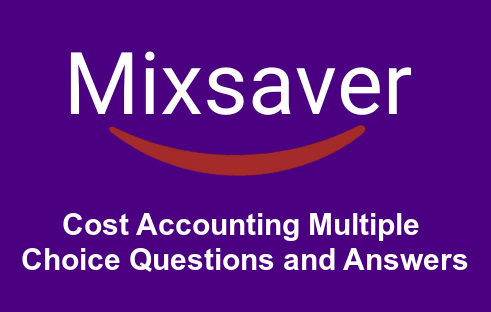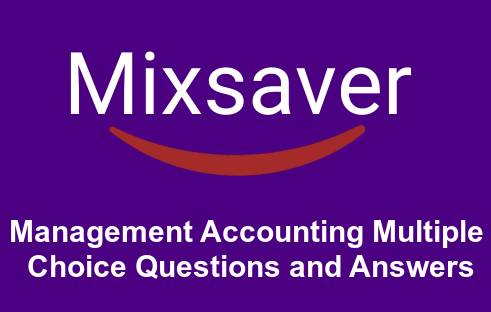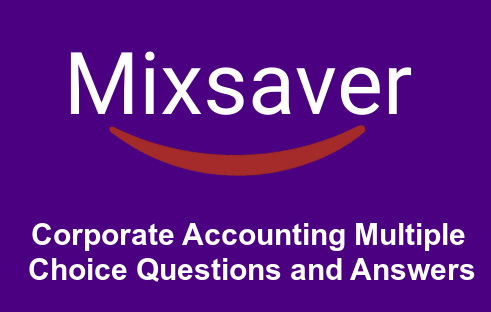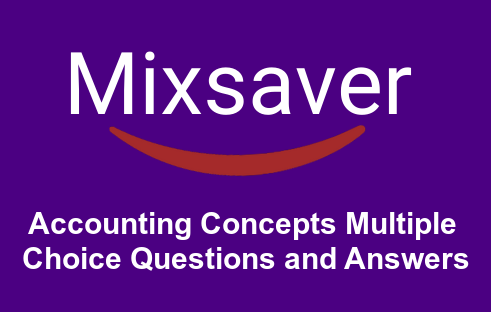Cost Accounting Solved MCQs | Cost Accounting Multiple Choice Questions and Answers doc
1. The main objective of cost accounting is to provide information to the management for
(a) planring
(c) policy-making
(b) decision-making
(d) None of these
Ans. b
2. Total costs of direct material, Jabour and expenses are included in
(a) distribution cost
(c) selling cost
(b) prime cost
(d) development cost
Ans. b
3. The ascertainment of costs after they had been incurred is known as
(a) differential costing
(c) historical costing
(b) replacement costing
(d) predetermined costing
Ans. c
4. …….. is a technique of cost control.
(a) Marginal conting
(c) Job costing is a technique of cost control.
(b) Standard costing
(d) Contract costinig
Ans. b
5. A cost, in which payment is made to a factor of production is referred to as
(a) opportunity cost
(c) absolute cost
(b) imputed cost
(d) out of pocket cost
Ans. d
6. Cost centre comprising of a person or a group of persons is referred to as
(a) operation oost centre
(c) service cost centre
(b) functional cost ceritre
(d) personal cost centre
Ans. d
7. A cycle manufacturing company will generally use the ….. method of costing.
(a) job costing
(b) multiple costing
(c) unit costing
(d) process costing
Ans. b
8. The process of distributing an item of cost over several cost centres is known as
(a) cost absorption
(c) cost allocation
(b) cost apportionment
(d) None of these
Ans. b
9. Interest on capital, payment for which is not made, is an example of
(a) Imputed cost
(c) replacement cost
(b) sunk cost
(d) opportunity cost
Ans. a
Cost Accounting MCQ Book
11. ……method of costing will be suitable for oil refineries.
(a) Operation costin
(c) Job costing
(b) Process costing
(d) Batch costing
Ans. b
11. Cost unit applicable to hotels providing lodging facility, will be
(a) per room, per day
(c) per passenger, per day
(b) per bed, per day
(d) None of these
Ans. a
12. Overhead costs of operating a machine may be absorbed by using
(a) rate per second of operating the machine
(b) rate per minute of operating the machine
(C) rate per hour of operating the machine
(d) Either ‘a’ or ‘b
Ans. c
13. A cost centre which is formed to render services to production centres is known as
(a) service cost centre
(c) production cost centre
(b) process cost centre
(d) functional cost centre
Ans. a
14. Bin card is also known as
(a) stores ledger
(c) material bill
(b) stock card
(d) None of these
Ans. b
15. In ………. method, the price of the oldest available stock is taken as the issue price.
(a) weighted average
(c) FIFO
(b) LIFO
(d) HIFO
Ans. c
16. The quantity of material which is ordered at the time of placing an order is referred to as
(a) ABC quantity
(c) maximum quantity
(b) minimum quantity
(d) economic order quantity
Ans. d
17. …….. are incurred every time an order is placed and include cost of placing an order, transportation cost, cost of inspecting goods, etc.
(a) Storage costs
(c) Either ‘a’ or ‘b’
(b) Ordering costs
(d) None of these
Ans. b
18. . . are incurred on the maintenance of material in stores and comprise of costs related to handling, obsolescence, pilferage, etc.
(a) Carrying costs
(c) Either ‘a’ or ‘b’
(b) Ordering costs
(d) None of these
Ans. a
19. In case of inter-departmental issue of material, …. is issued.
(a) credit note
(c) material transfer note
(b) debit note
(d) stores requisition note
Ans. d
20. ABC analysis is a technique of
(a) cost control
(b) budgetary control
(d) None of these
(c) inventory control
Ans. c
cost accounting mcq pdf | solved mcqs of cost and management accounting pdf | cost accounting mcq with answers pdf
21. A manufacturer uses 7,500 units of a material ‘Z’ per year. The material cost is rs. 15 per unit and carrying cost is 40% per annum of average inventory cost. The cost of placing order is rs. 36. Calculate EOQ and number of orders placed per annum.
(a) 250 units, 30 times
(c) 500 units, 15 times
(b) 300 units, 25 times
(d) 150 units, 50 times
Ans. b
22. The minimum stock level and average stock level of raw material Alpha’ are 4,000 and 9,000 units respectively. The re-order quantity will be
(a) 10,000 units
(c) 14,000 units
(b) 12,000 units
(d) 16,000 units
Ans. a
24. The EOQ will be
(b) 800 units
(d) 900 units
(a) 1.000 units
(c) 600 units
Ans. c
25. Number of orders placed each year will be
(a) 100 orders
(c) 80 orders
(b) 120 orders
(d) 75 orders
Ans. a
26. The time gap between two orders will be
(b) 3.6 days
(a) 4 days
(c) 3.6 days
(d) 5 days
Ans. b
27. Total ordering costs for EOQ will be
(b) rs. 11,000
(d) rs. 9,000
(a) rs.12,000
(c) rs. 10,000
Ans. d
28. Total carrying costs for EOQ will be
(a) rs. 9,000
(c) rs. 18,000
(b) rs. 10,000
(d) rs. 20,000
Ans. a
29. Total of carrying and storage costs will be
(a) rs. 20,000
(c) rs. 24,000
(b) rs.18,000
(d) rs. 30,000
Ans. b
Basic Cost Accounting mcqs pdf | Advanced Cost Accounting MCQs with answers pdf
31. Method to measure labour turnover is
(a) separation method
(b) repiacement method
(c) flux method
(d) All of the above
Ans. d
32. The percentage of bonus offered under Rowan plan is
(a) 50%
(b) 40%
(c) 33 1/3%
(d) fluctuating
Ans. d
33. The cost of abnormal idle time is transferred to
(a) costing manufacturing A/c
(b) costing profit and loss A/c
(c) costing trading A/c
(d) None of the above
Ans. b
34. The unavoidable cause which compel workers to leave their job is
(a) seasonal nature of businessi
(b) lack of proper working conditions
(C) lack of developmental opportunities
(d) unhealthy relation with management
Ans. a
35. Time and motion study is conducted with an aim to classify the labour movements into
(a) fixed and variable
(b) direct and indirect
(c) avoidable and unavoidable
(d) None of the above
Ans. c
36. A worker is allowed 50 hours to complete his job with a guaranteed wage rate of rs. 12 per hour. Under the Rowan plan, his effective wage earnings are rs. 15 per hour. What will be his earnings under Halsey plan?
(a) rs. 750
(b) rs. 525
(c) rs. 600
(d) rs. 550
Directions Q. No 37 to 39 are based on the information given below.
The labour turnover rates of a manufacturing organisation for the half-yearly ended 30th June, 2015 are 10% 5% and 3% under flux method, replacement methnd and separation method respectively. The number of workers replaced during the quarter is 1,500.
37. The average number of workers in the organisatio
(a) 30,000
(c) 75,000
(b) 40.000
(d) 50,000
Ans. a
38. The number of workers who left their job durg period is
(a) 1,500
(c) 1,000
(b) 900
(d) None of these
Ans. b
39. The number of workers who left including replacemens.
(a) 800
(b) 1,000
(c) 5.000
(d) 3.000
Directions Q. No. 40 and 41 are based on the informat n git below. A worker takes 7 hours to complete a job under a scheme of payment by results. Standard time allowed for the job is 10 hours. Wage rate is rs. 50 per hour.
40. The wages of the workers under Halsey plan will be
(a) rs. 400
(c) rs. 350
(b) rs. 425
(d) rs. 500
Ans. b
41. The wages of the worker under Rowan plan will be
(a) rs. 375
(c) rs.350
(b) rs. 425
(d) rs. 455
Ans. d
Cost and Management Accounting MCQs with Answers pdf
42. Which of the following item(s) is/are included in overheads?
(a) Depreciation on office furniture
(b) Rent of office building
(c) Electricity charges of office
(d) All of the above
Ans. d
43. Overheads which vary in direct proportion with change in the level of activity are referred to as
(a) controllable overheads
(c) fixed overheads
(b) uncontrollable overheads
(d) variable overheads
Ans. d
44. Allocation and apportion of costs over production and service departments are done in the
(a) primary distribution table
(b) secondary distribution table
(c) preliminary distribution table
(d) None of the above
Ans. a
45. Administrative overheads include
(a) audit and legal fees
(b) affice rent, rates and taxes
(C) salarnes of administrative staff
(d) All of the above
Ans. d
46. Salary paid to supervisor is an example of
(a) selling overhead
(b) production overhead
(c) manufacturing overhead
(d) administrative overhead
Ans. c
47. A common absorption rate used throughout a factory for all jobs, irrespective of the department in which they were produced, is called
(a) machine hour rate
(b) blanket absorption rate
(c) overall absorption rate
(d) None of these
Ans. b
48. Most suitable basis for apportioning the insurance charges for machines would be
(a) value of machines
(b) floor area occupied by machines
(c) number of machines
(d) number of workers working on a machine
Ans. a
49. Calculate the cost of power per hour, if power consumption of machine during operation is 20 units and rate of power per 100 unit is rs. 600.
(a) rs. 120
(b) rs. 30
(c) rs.100
(d) rs. 600
Ans. a
50. When actual overheads are more than the absorbed overheads, it is known as
(a) under-absorption of overheads
(b) over-absorption of overheads
(c) Either ‘a’ or ‘b’
(d) None of the above
Ans. a
51. “Under/over-absorption of overheads occurs only when a predetermined rate of overhead absorption is used”. The given statement is
(a) true
(c) partly true
(b) false
(d) partly false
Ans. a
52. Cost of direct materials consumed is equal to
(a) Prime cost – Direct labour cost – Direct expenses
(b) Prime cost – Direct labour cost + Direct expenses
(c) Prime cost + Direct labour cost Direct expenses
(d) Prime cost+ Direct labour cost + Direct expenses
Ans. a
53. Calculate the value of closing stock from the following information. Opening stock of finished goods (1,000 units): rs. 5,000 cost of production (20,000 units) is rs. 120,000 Closing stock of 3,000 units is
(a) rs. 15,000
(b) rs.17,857
(c) rs. 18,000
(d) None of the above
Ans. c
54. In contract costing, all direct costs are debited to
(a) profit and loss account
(c) contract account
(b) trading account
(d) None of these
Ans. c
55. Notional profit can be calculated with the help of which formula?
(a) Notional profit = (Value of work certified + Cost of work uncertified) + Cost of work done till date
(b) Notional profit = (Value of work certified + Cost of work uncertified) – Cost of work done till date
(c) Notional profit = (Value of work certified Cost of work uncertified) Cost of work done till date
(d) None of the above
Ans. b
56. . clause is inserted in the contract to protect the contractor from an unexpected rise in the cost of material.
(a) Reserve
(c) Escalation
(b) Inflationary
(d) De-escalation
Ans. c
57. If work certified is ., then nothing is transferred to costing profit and loss account.
(a) less than 30%
(c) less than 50%
(b) less than 45%
(d) less than 25%
Ans. d
58. When the cash ratio is 80%, then the retention money is equal to
(a) 10%
(b) 15%
(c) 20%
(d) None of these
Ans. c
59. The contract price is rs. 7,50,000. 75% of the work is certified. The contacted has given payment for 80%. Find the amount received by the contractor.
(a) rs. 5,62,500
(b) rs. 6,00,000
(c) rs. 4,50,000
(d) None of these
Ans. b
60. ……… costing is suitable for industries engaged in mass production.
(a) Job
(c) Process
(b) Contract
(d) Batch
Ans. d
61. ….. method of costing is used in industries where goods move from one process to another until their final completion.
(a) Job
(c) Contract
(b) Process
(d) Batch
Ans. b
62. In process costing, cost per unit of production increases due to
(a) normal loss
(b) normal gain
(d) abnormal gain
(c) abnormal loss
Ans. a
63. The raw material lost in processing, having no recovery value is known as
(a) scrap
(b) waste
(c) spoilage
(d) None of these
Ans. b
64. Abnormal losses are … … to the process account and .. …. to the abnormal loss account.
(a) credited, debited
(c) credited, credited
(b) debited, credited
(d) debited, debited
Ans. a
65. 2,500 kgs of material ‘X’ are introduced in process ‘A’. Expected normal loss is 2%. Actual output from the process is 2,400 kgs. The amount of abnormal loss will be
(a) 55 kgs
(c) 100 kgs
(b) 50 kgs
(d) no abnormal loss
Ans. b
66. A product which arises incidentally in the production of the main product and which has a relatively small sales value as compared with main product is known as
(b) joint-products
(a) scrap
(c) by products
(d) wastage
Ans. c
67. .. . are the costs which are common to the processing of joint products or by products upto the point of separation.
(a) Joint costs
(b) Common costs
(c) Pre-separation costs
(d) None of the above
Ans. b
68. Under ….. accounting, separate ledgers for financial and cost accounting are maintained.
(a) financial book-keeping
(b) integrated
(c) non-integrated
(d) None of the above
Ans. c
69. Maintenance of .. … accounts avoids duplication of efforts and reconciliation of cost and financial accounts is not required.
(a) non-integrated
(c) cost
(b) integrated
(d) financial
Ans. b
70.Integrated accounts merge …… in one set of accounts.
(a) cost and financial accounts
(b) cost and management accounts
(c) management and financial accounts
(d) None of the above
Ans. a





